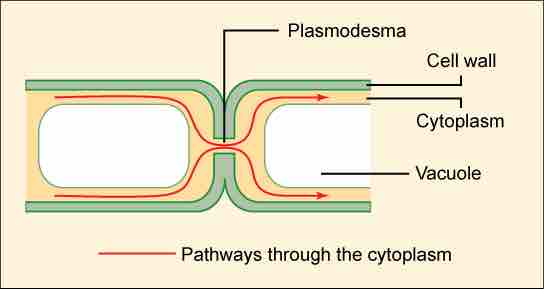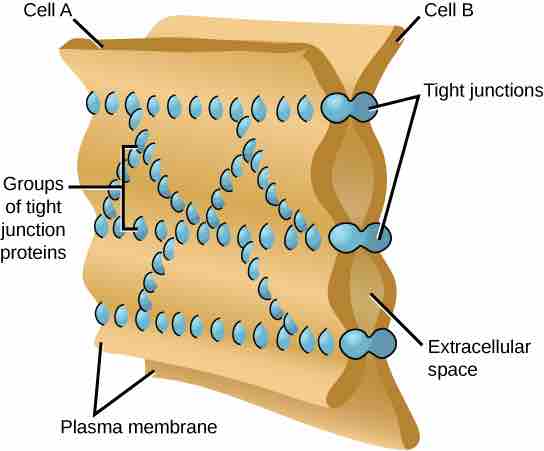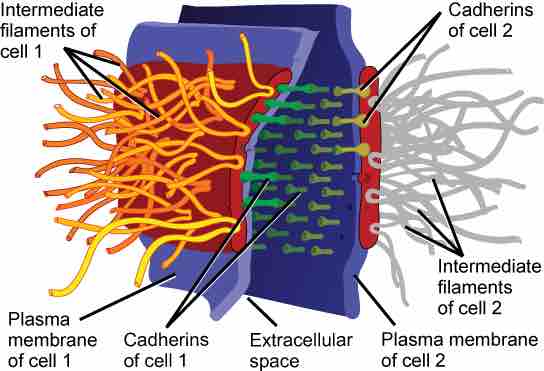Intercellular Junctions
The extracellular matrix allows cellular communication within tissues through conformational changes that induce chemical signals, which ultimately transform activities within the cell. However, cells are also capable of communicating with each other via direct contact through intercellular junctions.
There are some differences in the ways that plant and animal cells communicate directly. Plasmodesmata are junctions between plant cells, whereas animal cell contacts are carried out through tight junctions, gap junctions, and desmosomes.
Junctions in Plant Cells
In general, long stretches of the plasma membranes of neighboring plant cells cannot touch one another because they are separated by the cell wall that surrounds each cell. How then can a plant transfer water and other soil nutrients from its roots, through its stems, and to its leaves? This transport primarily uses the vascular tissues (xylem and phloem); however, there are also structural modifications called plasmodesmata (singular: plasmodesma) that facilitate direct communication in plant cells. Plasmodesmata are numerous channels that pass between cell walls of adjacent plant cells and connect their cytoplasm; thereby, enabling materials to be transported from cell to cell, and thus throughout the plant .

Plasmodesmata
A plasmodesma is a channel between the cell walls of two adjacent plant cells. Plasmodesmata allow materials to pass from the cytoplasm of one plant cell to the cytoplasm of an adjacent cell.
Junctions in Animal Cells
Communication between animal cells can be carried out through three types of junctions. The first, a tight junction, is a watertight seal between two adjacent animal cells . The cells are held tightly against each other by proteins (predominantly two proteins called claudins and occludins). This tight adherence prevents materials from leaking between the cells. These junctions are typically found in epithelial tissues that line internal organs and cavities and comprise most of the skin. For example, the tight junctions of the epithelial cells lining your urinary bladder prevent urine from leaking out into the extracellular space.

Tight Junctions
Tight junctions form watertight connections between adjacent animal cells. Proteins create tight junction adherence.
Also found only in animal cells are desmosomes, the second type of intercellular junctions in these cell types. Desmosomes act like spot welds between adjacent epithelial cells, connecting them . Short proteins called cadherins in the plasma membrane connect to intermediate filaments to create desmosomes. The cadherins join two adjacent cells together and maintain the cells in a sheet-like formation in organs and tissues that stretch, such as the skin, heart, and muscles.

Desmosomes
A desmosome forms a very strong spot weld between cells. It is created by the linkage of cadherins and intermediate filaments.
Lastly, similar to plasmodesmata in plant cells, gap junctions are the third type of direct junction found within animal cells. These junctions are channels between adjacent cells that allow for the transport of ions, nutrients, and other substances that enable cells to communicate. Structurally, however, gap junctions and plasmodesmata differ. Gap junctions develop when a set of six proteins (called connexins) in the plasma membrane arrange themselves in an elongated doughnut-like configuration called a connexon. When the pores ("doughnut holes") of connexons in adjacent animal cells align, a channel between the two cells forms. Gap junctions are particularly important in cardiac muscle. The electrical signal for the muscle to contract is passed efficiently through gap junctions, which allows the heart muscle cells to contract in tandem.